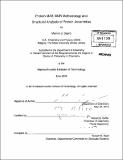| dc.contributor.advisor | Robert G. Griffin. | en_US |
| dc.contributor.author | Bayro, Marvin J | en_US |
| dc.contributor.other | Massachusetts Institute of Technology. Dept. of Chemistry. | en_US |
| dc.date.accessioned | 2010-08-31T14:49:11Z | |
| dc.date.available | 2010-08-31T14:49:11Z | |
| dc.date.copyright | 2010 | en_US |
| dc.date.issued | 2010 | en_US |
| dc.identifier.uri | http://hdl.handle.net/1721.1/57800 | |
| dc.description | Thesis (Ph. D.)--Massachusetts Institute of Technology, Dept. of Chemistry, 2010. | en_US |
| dc.description | Vita. Cataloged from PDF version of thesis. | en_US |
| dc.description | Includes bibliographical references. | en_US |
| dc.description.abstract | Methodological developments and applications of solid-state magic-angle spinning nuclear magnetic resonance (MAS NMR) spectroscopy, with particular emphasis on the analysis of protein structure, are described in this thesis. MAS NMR studies of biomolecules ranging from model peptides and proteins in crystalline form to amyloid fibrils and whole bacterial organelles are reported. The methods presented include novel pulse sequences and optimized pulse sequence elements, experimental approaches designed for multiple-spin systems, a protocol for efficient sequential resonance assignment of proteins in the solid state, and techniques to determine the inter-molecular organization of amyloid fibrils formed by moderately sized proteins. Notably, an efficient dipolar recoupling technique, bandselective radio frequency-driven recoupling (BASE RFDR), is introduced and combined with alternating 13C-12C labeling to yield highly sensitive 13C-13C correlation spectra between distant nuclei in proteins. Various applications of the BASE RFDR scheme are presented, including protein resonance assignment, determination of tertiary structure of amyloid fibrils, and variable-temperature studies of protein dynamics. The main biological systems analyzed are amyloid fibrils formed by the SH3 domain of P13 kinase (P13-SH3) and intact gas vesicles from anabaena flos-aquae, for which atomic-level structural information was previously unavailable. P13-SH3 (86 residues) is a system thoroughly studied as a model of protein misfolding and amyloid formation by a natively globular protein. Gas vesicles are bacterial buoyancy organelles, with walls composed almost entirely by a single protein (GvpA, 70 residues), whose formation and structure constitute a highly intriguing biophysical problem. Nearly complete 13C and 'IN resonance assignments and the molecular conformations of the polypeptide backbones of both P13-SH3 and GvpA have been obtained via MAS NMR spectroscopy, enabling the proposal of models for the structure of these two protein assembly systems. In addition, the tertiary structure of P13-SH3 amyloid fibrils has been elucidated by the application of novel methodology introduced in this thesis. Finally, investigations regarding the effects of temperature and protein dynamics on MAS NMR experiments and biomolecular dynamic nuclear polarization studies are presented. | en_US |
| dc.description.statementofresponsibility | by Marvin J. Bayro. | en_US |
| dc.format.extent | 344 p. | en_US |
| dc.language.iso | eng | en_US |
| dc.publisher | Massachusetts Institute of Technology | en_US |
| dc.rights | M.I.T. theses are protected by
copyright. They may be viewed from this source for any purpose, but
reproduction or distribution in any format is prohibited without written
permission. See provided URL for inquiries about permission. | en_US |
| dc.rights.uri | http://dspace.mit.edu/handle/1721.1/7582 | en_US |
| dc.subject | Chemistry. | en_US |
| dc.title | Protein MAS NMR methodology and structural analysis of protein assemblies | en_US |
| dc.type | Thesis | en_US |
| dc.description.degree | Ph.D. | en_US |
| dc.contributor.department | Massachusetts Institute of Technology. Department of Chemistry | |
| dc.identifier.oclc | 654473810 | en_US |
